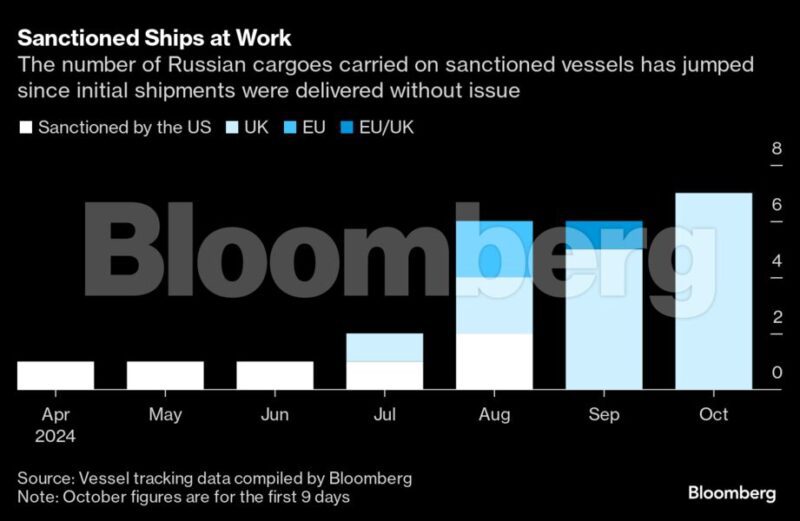Canada to Drop Many Counter-Tariffs in Olive Branch to Trump
By Brian Platt and Josh Wingrove Aug 22, 2025 (Bloomberg) –Canada will remove its retaliatory tariffs on a long list of US products that comply with the existing North American trade...
By Julian Lee (Bloomberg) Moscow’s use of the tankers sanctioned for their involvement in the Russian oil trade is accelerating, with close to one-third of the blacklisted vessels back at work.
At least 21 of the 72 tankers sanctioned by the US Treasury Department’s Office of Foreign Assets Control, the UK Treasury or the European Union in the past year have loaded a total of 24 cargoes of Russian oil since they were designated in response to Moscow’s 2022 invasion of Ukraine.
A combination of increased confidence from buyers and — in particular — a lack of concern about measures imposed by London have likely helped Moscow and its customers to find workarounds.
The rate at which the tankers are being brought back into operation is increasing, with at least seven taking on cargoes in the first ten days of October, according to vessel tracking data compiled by Bloomberg. That’s up from six in both August and September and just five in total before that.

Initially, the blacklisted tankers remained idle. None of the sanctioned vessels carried a single cargo of Russian, or any other, oil until April — six months after the first ships were named. Since those first cargoes were delivered successfully, the use of the sanctioned tankers has soared.
The first sanctions were imposed by the US on Oct. 12, 2023, when it took action against two ships, the SCF Primorye and the Yasa Golden Bosphorus, for transporting Russian oil sold above a price cap of $60 a barrel that had been imposed to restrict Moscow’s oil income.
Also Read: Chinese Vessels Race to Deliver Power Plant To Sanctioned Arctic LNG Project Before Winter
The UK government began naming individual ships in June, followed by the EU later that month. In total, 73 were named, with nine sanctioned by more than one authority. One tanker, the Yasa Golden Bosphorus, was removed from the US sanctions list in April.

Measures imposed by the UK seem to be the least effective. Almost two-thirds of the total cargoes loaded so far have been carried by vessels sanctioned by London. All of the tankers put to work in September and October have been sanctioned by Britain, with only one of them also targeted by Brussels.
It means two-thirds of all the ships sanctioned by the UK are now back at work.
In contrast, the US action appears to have been more effective. Just six cargoes have been carried on four of the 39 tankers blacklisted by Washington. Most of those targeted by OFAC have remained idle since being named, some for almost 11 months.
Separately, 50 of the ships have been renamed since being sanctioned, many being reflagged at the same time. Thirteen of the sanctioned ships now sail under the flag of Barbados, whose ship registry is quartered in the country’s High Commission in London.
Most of the crude cargoes have headed to Chinese ports, but about one-third have ended up in India — a sign that the country’s previous reluctance to deal with sanctioned entities now a thing of the past.
While all the early shipments on sanctioned tankers were loaded at Novorossiysk on Russia’s Black Sea coast, more recent cargoes have been collected at almost all Russia’s export ports. In part, that reflects the decision by the UK authorities to name vessels that operate exclusively out of Russia’s Pacific ports.
Even if the sanctioned ships are idled again, the blacklisted tankers are just a tiny part of the shadow fleet amassed by Russia to move its crude and refined products outside the reach of the Western powers. That’s curtailed the effectiveness of the measures, with plenty of other ships available to keep the oil, and the Kremlin’s income, flowing.
Read Next: In Desperate Move Russia Sends First-Ever Conventional LNG Carrier Through Arctic
© 2024 Bloomberg L.P.

Sign up for gCaptain’s newsletter and never miss an update

Subscribe to gCaptain Daily and stay informed with the latest global maritime and offshore news


Stay informed with the latest maritime and offshore news, delivered daily straight to your inbox
Essential news coupled with the finest maritime content sourced from across the globe.
Sign Up